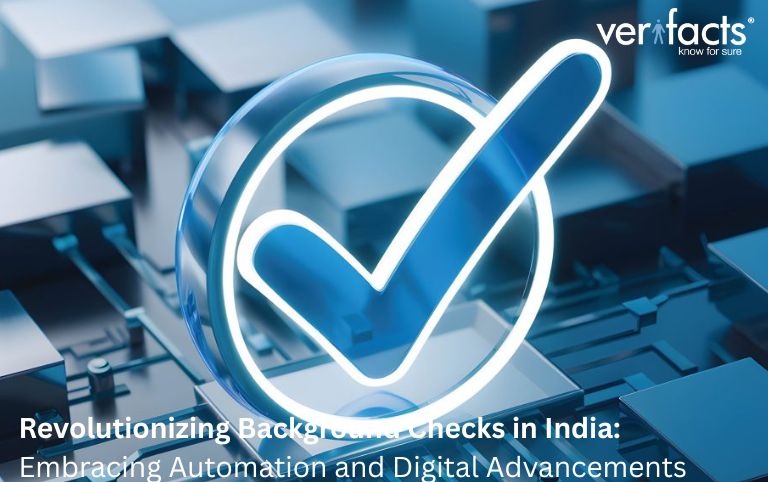
The background screening landscape in India is witnessing a paradigm shift, driven by rapid digitisation, automation, and the introduction of regulatory frameworks like the Digital Personal Data Protection Act (DPDPA) 2023. As businesses aim for faster hiring cycles, enhanced compliance, and better candidate experiences, automation emerges as the cornerstone of modern verification practices.
Traditionally, background screening in India relied heavily on manual processes due to fragmented and complex record systems. Today, government-led initiatives linking records with Aadhaar and other digital identifiers are reshaping this ecosystem.
-
Automated Record Retrieval: Digitisation ensures faster turnaround times without compromising on accuracy.
-
Discrepancy Management: With 88% of Indian respondents encountering employment discrepancies and 44% education-related inconsistencies (Verifacts survey), digitisation helps proactively identify and resolve them.
-
Strategic Imperative for HR Leaders: By embracing automation, HR leaders can balance recruitment efficiency with robust due diligence.
The rise of moonlighting—accelerated by remote work post-COVID—has become a growing concern for employers. Automation provides a strategic advantage here:
-
UAN & Provident Fund Checks: Automated employment verification through Universal Account Numbers (UAN) and provident fund data enables quick detection of multiple employments.
-
Accuracy Over Manual Processes: Eliminates dependence on physical verification, reducing uncertainty and improving reliability.
-
Risk Mitigation: Employers gain confidence in safeguarding productivity and intellectual property by proactively addressing moonlighting risks.
The DPDPA 2023 marks a significant shift in India’s approach to personal data security and compliance. For background screening, this brings both opportunities and responsibilities:
-
Data Governance: Companies must align with clear consent-based data processing norms.
-
Vendor Partnerships: Screening providers must demonstrate compliance-readiness, ensuring secure handling of sensitive data.
-
Regulatory Alignment: Differentiating between digital vs. physical records, recruitment platforms, and third-party vendors becomes critical for compliance.
-
AI-Driven Insights: As AI integrates into screening systems, data protection and ethical usage will remain under scrutiny.
Speed is emerging as a decisive factor in choosing a screening provider—75% of respondents prioritize turnaround time. Automation directly addresses this need:
-
Police Checks & ID Verification: Digital integration with government systems drastically reduces waiting periods.
-
Education & Employment Verification: Automated systems reduce manual follow-ups, ensuring timely results.
-
Candidate-Centric Approach: Faster verification processes reflect positively on employer branding, creating a seamless onboarding journey.
Adopting automation in background screening is not just about speed—it creates holistic value across the hiring cycle:
-
Efficiency & Time Savings ⏳ – Streamlined workflows minimize delays and accelerate hiring.
-
Consistency & Accuracy ✅ – Automated checks reduce human error and ensure reliable outcomes.
-
Compliance Assurance 📜 – A trusted vendor ensures adherence to DPDPA and other regulations.
-
Enhanced Candidate Experience 🤝 – Quick, transparent results foster trust and improve onboarding experiences.
-
Strategic Resource Allocation 🎯 – HR teams can shift focus from repetitive tasks to talent development and business priorities.
While speed is critical, maintaining quality and depth of verification remains non-negotiable. According to Verifacts data, 50% of participants prioritize recruitment efficiency without compromising quality.
-
Employers must partner with vendors who balance automation-driven speed with rigorous verification standards.
-
Over-reliance on speed without validation may expose organizations to risks of misrepresentation.
As India transitions into a more digital-first economy, background screening will evolve into a strategic enabler of trust in hiring. HR leaders must:
-
Reassess existing screening practices for automation readiness.
-
Align with the DPDPA framework to ensure ethical and compliant data handling.
-
Foster a candidate-first approach to enhance employer reputation.
-
Leverage government-backed digitisation initiatives for faster, reliable verifications.
Automation and digitisation are no longer optional—they are essential catalysts for the future of background screenings in India. By strategically embracing automation, ensuring compliance with the Digital Personal Data Protection Act, and prioritizing both speed and quality, organizations can create a secure, efficient, and candidate-friendly hiring ecosystem.
🚀 The future of background screening belongs to those who balance technology, compliance, and human trust.

